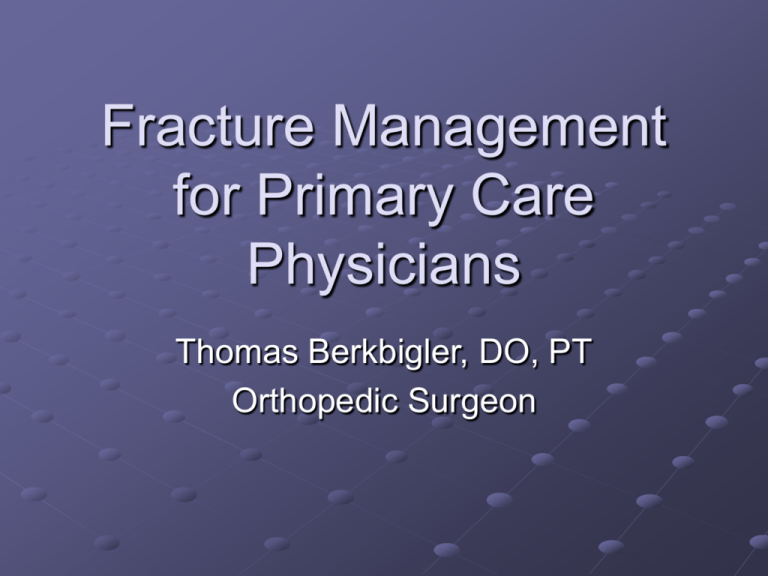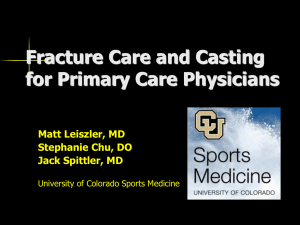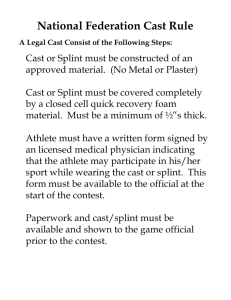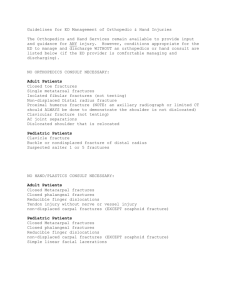Fracture Management for Primary Care Physicians
advertisement

Fracture Management for Primary Care Physicians Thomas Berkbigler, DO, PT Orthopedic Surgeon Disclosures None that I am aware of that will bias this talk Why are we discussing this? Orthopedic problems are over 10% of all primary care visits 1.6% of all visits to any physician are fracture related 16% of all fracture care is handled by family physicians Objectives 1. 2. 3. 4. 5. 6. 7. 8. Identify common fractures in Primary Care Proper use of a splint versus a cast Identify commonly used casting materials and when to use them Demonstrate proper cast application and removal Describe appropriate patient education with regards to casting Understand general fracture principles, when to refer out fracture care Understand management of specific fractures Recognize osteoporotic fractures General Principles Two (2) Principle Questions 1. What to Refer? How to stabilize 2. What to Manage on my own? How to treat what I keep Casting - Overview Mainstay of treatment for most fractures Joint above and a joint below Avoid pressure points Proper molding Cast indentations Appropriate padding More at bony prominence Not too much at fracture site Consider skin wounds Splinting - Overview Purpose Reduce pain Reduce bleeding and swelling Prevent further soft tissue damage Prevent vascular constriction What to splint Fracture Dislocation Tendon rupture Supplies Stockinette Padding material Cast material Plaster: cheaper, long shelf life, easier to work with May be fragile, disintegrate in water Fiberglass: more durable, lighter, dry quicker, multiple colors, water tolerant Newer synthetic materials Procedure Apply stockinette Protect skin and provide smooth edge Apply padding Protect bony prominence Allows for swelling Wet the casting material Hot water hardens faster Squeeze out excess water Apply splint or cast Patient Instructions Keep injured limb elevated and iced Warning signs Numb extremity - Inability to move extremity Discoloration, Cold - Increased pain Avoid getting wet Completely with plaster May use hair dryer on cool setting if fiberglass Anti-histamines Splint Types Upper Extremity: Wrist Cock-up Ulnar Gutter Long arm Splint -Sugar-tong -Radial Gutter -Coaptation Lower Extremity: Posterior Ankle slab Long leg splint -Stir-ups Take Home Points You will see fractures Know your comfort level and when to refer Splint acutely and with active swelling Variety of materials Know what you have, be comfortable with it Educate your patients Fractures General Principles Two (2) Principle Questions 1. What to Refer? 1. How to stabilize 2. What to Manage on my own? How to treat what I keep OLD ACIDS Mnemonic O: open or closed L: location D: degree A: articular involvement C: comminution/type I: instrinsic bone quality D: displacement S: soft tissue injury Metatarsal / Phalanges Keep 1. 2. 3. Minimally/Non-displaced fractures Short leg cast NWB 4-8 weeks Refer 1. 2. 3. 4. Lis Franc fracture or Jones Fracture Displaced Metatarsal Shaft or intra-articular fractures Multiple fractures Short leg splint; NWB Ankle Fractures Keep: Avulsion fractures and some Weber A type Some Weber B fractures Need stress radiograph Splint : posterior slab +/- stirrups x1 week Cast: Short leg x2-6 weeks NWB 2-8 weeks AROM ~4 weeks PT for ankle strengthening and proprioceptive training Ankle Fractures Refer: Bi/Trimalleolar Fractures Bimalleolar Equivalency Fractures Talar subluxation Articular impaction Syndesmosis dysruption Treatment: Reduce and Splint (Posterior slab with stirrups) Significant Joint involvement – Obtain post-reduction CT Clavicle Fractures Keep Shaft type with minimal displacement and shortening Sling or Figure 8 for 4-6 weeks ROM/Strengthening thereafter Refer Comminution, shortening, distal/proximal type Sling Proximal Humerus Fracture Neer Classification 1. 2. 3. 4. Helps determine treatment 1-Part 2-Part 3-Part 4-Part Proximal Humerus Majority need close follow up with Orthopedics Even if non-displaced initially may displace later or present with later stage rotator cuff issues. Sling or Sling and Swathe Osteoporotic Fracture • Distal Radius Most common orthopaedic injury with a bimodal distribution younger patients - high energy Elderly patients – low energy fall (OP) Manage? Non-displaced extra-articular Well reduced extra-articular with good bone quality in a well-molded cast/splint Distal Radius Fractures Barton's A depressed fracture of the lunate fossa of the articular surface of the distal radius Fx dislocation of radiocarpal joint with intra-articular fx involving the volar or dorsal lip (volar Barton or dorsal Barton) Chauffer's Radial styloid fx Die-punch Colles' Smith's Low energy, dorsally displaced, extra-articular Low energy, volar displaced, extra-articular fx Take home point…understand the energy Surgical Options How to treat? Options: Splint and refer? Splint and cast later? Reduce and splint? Cast and manage? Reduce and Cast? Scaphoid Fractures Scaphoid is most frequently fractured carpal bone; 15% of wrist injuries Prognosis incidence of AVN with fracture location Proximal 1/5 = 100% Proximal 1/3 = 33% Wrist pain after fall Splint vs. Cast 2 weeks Repeat xrays – no fx, continued snuff box pain and pain with pronation = MRI Refer out – thumb spica splint or cast Oops… If texting an image…please include the whole xray Osteoporosis By Definition: Fall from standing resulting in Proximal Humerus, Distal Radius, Hip fracture, Spine compression fracture CBC, CMP, T4, TSH, Vit D3 level Bisphosphonate? Forteo? Drug class: Parathyroid Hormone Analog Question #1: In General, when should a splint be applied to a fracture, in lieu of a cast? 1. 2. 3. 4. 5. In the acute presentation Highly swollen extremity Compromised Skin None of the above All of the above #1 Answer 5. All of the above Question #2: 1. 2. 3. 4. 5. 6. Which Fracture when obtained in an adult from a simple fall does not meet criteria for Osteoporosis? Femoral Neck Fracture Scaphoid Fracture Hip Intertrochanteric Fracture L2 Compression Fracture Distal Radius Colles Fracture Comminuted 4-Part Proximal Humerus Fracture #2 Answer 2. Scaphoid Question #3: 1. 2. 3. 4. 5. Which Metatarsal Fracture is easily treated by a Primary Care Physician? Jones Fracture Fifth (5th) Metatarsal Avulsion fx Lis Franc Fracture Marching Fractures Widening of the 1st Inter-metatarsal web space #3 Answer 2. Fifth (5th) Metatarsal Avulsion fx Question #4: 1. 2. 3. 4. 5. What are some complications with elderly distal radius “Colles” fractures? Continued fracture collapse Carpal Tunnel Syndrome Skin Tears – from fall or from reduction Loss of ROM Profound dexterity achievement after cast immobilization #4 Answer 4. Profound dexterity achievement after cast immobilization i.e. If you had poor piano skills before… Question #5: Which Clavicle is a good candidate for non-operative management? A B C D A B C D #5 Answer C References Eiff MP, et al. Fracture management for Primary Care, 2nd edition. Saunders. 2003. Honsik K, et al. Sideline splinting, bracing and casting of extremity injuries. Current sports Medicine Reports. 2003;2:147-154. Meredith RM, et al. Field splinting of suspected fractures: preparation, assessment, and application. The Phys and Sports Med. 1997;25(10). Calcaneus and Talus Keep None Short leg splint; NWB Complicated – High long-term pain rate Typically Higher energy fractures Tibia Shaft Fractures Keep Very few Most - Long leg splint and refer Minimal allowance for mal-alignment: trend is to stabilize surgically for early ROM Exceptions: Toddler’s Fracture Obtain phone consult of Orthopedist Elderly/Non-ambulatory – minimally displaced Well padded Long leg cast Femur Shaft Fractures Non-operative: only in the baseline nonambulatory or severely unhealthy Non-displaced: NWB 8-12 weeks Displaced: NWB essentially lifelong Operative: ORIF via Plate and screw construct versus IM Nail Hip Fractures – Femoral Neck Non-operative: only in the baseline nonambulatory or severely unhealthy Non-displaced: NWB 8-12 weeks Displaced: NWB essentially lifelong Operative: Closed reduction and perc screws; Hemi versus Total Hip Arthroplasty Hip Fracture - Intertrochanteric Non-operative: only in the baseline nonambulatory or severely unhealthy Non-displaced: NWB 8-12 weeks Displaced: NWB essentially lifelong Operative: Intramedullary Nail Device versus DHS type device • Humeral Shaft Fracture Complex Fractures Acceptable limits: <30° Anterior; <20° Var/val; <3cm shortening Associated with radial nerve palsy Refer most out Coaptation splint +/- long arm splint Definitive treatment: varied, Hanging arm cast, Sarmiento, ORIF, IM Nail Fractures About the Elbow Refer: Supracondylar, Intercondylar, Olecranon, intra-articular, displaced, elbow dislocation If elbow dislocation, reduce, long arm splint Radial Head/Neck Fx isolated minimally displaced (less than 2mm) fxs with no mechanical blocks Long arm splint x3-7 days, then early ROM Consider aspiration Mason Classification Type I Minimally displaced fx, no mechanical block to rotation, intra-articular displacement <2mm Type II Displaced fx >2mm or angulated, possible mechanical block to forearm rotation Type III Comminuted and displaced fx, mechanical block to motion Type IV (Hotchkiss modification)Radial head fx with elbow dislocation








